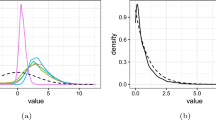Summary
A revision and extension of Vandermeer's algorithm for choosing size categories from demographic data is presented along with an example of its use. The extension permits an exact consideration of sample populations which may have different underlying transition probabilities at different census periods and/or within different subpopulations. Once categories are chosen transition matrices may be computed to investigate the dynamics of the population.
Similar content being viewed by others
References
Bierzychudek P (1982) The demography of Jack-in-the-pulpit, a forest perenniel that changes sex. Ecological Monographs 52:335–351
Charlesworth B (1980) Evolution in age-structured populations. Cambridge University Press, Cambridge
Fowler N (1984) Patchiness in patterns of growth and survival of two grasses. Oecologia (Berlin) 62:424–428
Fowler N, Antonovics J (1981a) Small scale variability in the demography of transplants of two herbaceous species. Ecology 62:1450–1457
Fowler N, Antonovics J (1981b) Competition and coexistence in a North America grassland. I. Patterns in undisturbed vegetation. J Ecol 69:825–841
Hartshorn GS (1972) The ecological life history and population dynamics of Pentaclethra macroloba, a tropical wet forest dominant and Strypnodendron excelsum, an occasional associate. Ph.D. Thesis, University of Washington, p 118
Keddy P (1980) Population ecology in an environmental mosaic: Cakile edentula on a gravel bar. Can J Bot 58:1095–1100
Keyfitz N (1968) Introduction to the Mathematics of Populations. Addison-Wesley, Reading, Mass
Kirkpatrick M (1984) Demographic models based on size, not age, for organisms with indeterminant growth. Ecology 65:1874–1884
Lefkovitch LP (1965) The study of population growth in organisms grouped by stages. Biometrics 21:1–18
Maegher TM (1982) The population biology of Chamaelirium luteum, a dioecious member of the lily family: two sex-population projections and stable population structure. Ecology 63:1707–1711
Sarukhan J, Harper J (1973) Studies on plant demography: Ranunculus repens L., R. bulbosus, and R. acris L. I. Population flux and survivorship. J Ecol 61:675–716
Snaydon R, Davies M (1972) Rapid population differentiation in a mosaic environment II. Morphological variation in Anthoxanthum odoratum. Evolution 26:390–405
Vandermeer J (1975) On the construction of the population projection matrix for a population grouped in unequal stages. Biometrics 31:239–242
Vandermeer J (1978) Choosing category size in a stage projection matrix. Oecologia (Berlin) 32:79–84
Weins J (1976) Population responses to patchy environments. Ann Rev Ecol Syst 7:81–120
Werner PA, Caswell HA (1977) Population growth rates and age versus stage-distribution models for teasel (Dipsacus sylvestris Huds.). Ecology 58:1103–1111
Author information
Authors and Affiliations
Rights and permissions
About this article
Cite this article
Moloney, K.A. A generalized algorithm for determining category size. Oecologia 69, 176–180 (1986). https://doi.org/10.1007/BF00377618
Received:
Issue Date:
DOI: https://doi.org/10.1007/BF00377618




